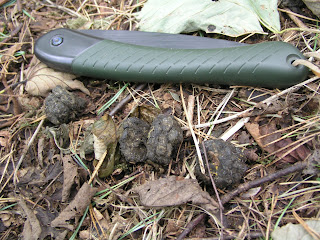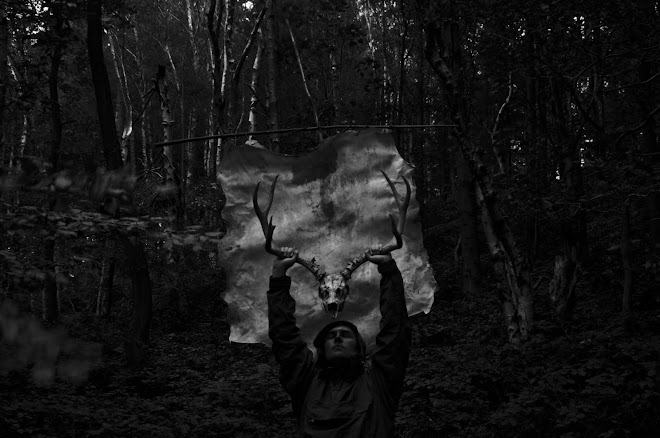



As I took to the narrow trail a wren which had remained silent whilst I stood on the main path began to tick noisily and flick its tail from bush to bush. The trail was thick with Roe slots, some quite large. The amount of cobwebs I had to brush from my face indicated that nothing above waist height had travelled down the trail recently, although a large dog print – something along the lines of a German Shepherd – showed that the trail was not unknown to either dog walkers or the nearby farm.
The trail rose and fell, hugging the south bank of a small ghyll, forcing me to bend low to get under branches and making me wince as my pack snagged dead twigs and snapped them off with sharp cracks. As the trail crested a rise at the edge of the wood I stopped and looked down at the open fields and the river beyond. Slightly off the trail I saw a pile of feathers, evidently once belonging to a hen pheasant. I remembered that this area of woodland had been used several years earlier by the farm to breed game birds, I had once stumbled across bags of feed and several mesh pens and from the steady croaky alarm of a pheasant to my left the woods obviously remained a popular area for the birds.
Stooping to examine the kill site I noted the ends of the quills had been snapped and torn – characteristic of the feeding behaviour of the Red Fox (Vulpes vulpes). There was precious little left of the bird, only a few scattered feathers – everything else had been devoured. I noticed a small scat in amongst the feathers – which looked dark and lumpy, almost like that of a sheep and certainly nothing like the classic sausage-shaped fox scat text books use to illustrate their pages. Although the scat was extremely atypical of the fox castings found in books it’s positioning with an obvious fox kill and it’s location at the point where the trail crested a rise pointed to fox sign. I photographed the site and carried on along the trail, now heading back in the direction I had come although hugging the edge of the wood rather than the middle.
Over the next hundred meters I came upon three further deposition sites used by this animal. In each case the casting had been left on the trail, usually at a high point or a site where a gap in the trees allowed a clear view to the fields. This animal was leaving very dark and lumpy scat that had fallen to the floor in thick, heavy splats. Examining the scat revealed it to be infested, to a greater or lesser extent, with small pearl-grey maggots with black ends. One of these castings, which had fallen in three separate pieces was heavily infested and also revealed a single larger, plumper orange-brown maggot. The larval stages of flies is not my strong suite so I could not estimate just how old the castings were, although a smaller casting found further along the trail appeared to the fresher and had fewer maggots of a smaller size. I left the maggots squirming in the sudden sunlight and thought of the wren that had protested as I entered the wood.
This animal, which had so thoroughly marked this trail along the edge of the wood with it scat, was enjoying a particularly meaty diet, taking pheasants from the woods and perhaps also scavenging around nearby Coldstream Farm. Its scats were black and viscous, falling in lumpy dollops and having sufficient meat waste to attract flies to lay eggs in the casting. There was no sign of berry seeds or the purple-black colouring that comes from a diet of berries – this fox was living off the fat of the land.
As the game trail petered out and merged again with the main path I noticed a movement in the bush some 20 meters ahead. I stood as still as I could and watched with amazement as a Roe doe came cautiously up the slope to my left and stood looking up and down the trail, like a child waiting to cross the road. The animal looked directly at me, I did not move and it appeared not to register me as a threat. It casually carried on, crossed the trail and disappeared down the slope to my right, immediately followed by a larger buck with impressively knobbly and pearled antlers. I was struck by how the Roe buck had allowed the doe to scout ahead for danger and how closely it stuck to her once she had decided to move. Both animals were much darker than the Roe I had seen in Cumbria in August – those deer had been a rich golden brown in contrast to the darker, sullen grey colour of these animals. Both deer were still within sight, picking their way slowly through the woods. I decided that I would risk a photograph and went to unzip my jacket. Either the sound or the movement alarmed them and they turned to look at me for a moment before bounding away, white rump flashes disappearing as they crashed through the brush.
As I reached the point where the deer had crossed the patch I became aware of a strong and quite offensive odour. Even as I stood the smell was dissipating and weakening. I have never smelled this around Roe before – the text books will tell you that the rut for Roe runs from mid July to Mid August but taking local factors into account and seeing how close the buck stuck to the doe it appears that in late September in Durham the rut is continuing.
Top: Pheasant killed and eaten by Red Fox
Second: Fox droppings at kill sight
Third: a further deposition also recorded as Scat # 1, 50 meters from earlier kill site. This scat was heavily infested with maggots
Bottom: a third deposition recorded as Scat # 1, some 100 meters from earlier kill site. This scat appeared to be fresh and was not as heavily infested as the previous dropping

No comments:
Post a Comment